As the first chaplain-in-residence for the 2020 CHQ Assembly, Margaret was interviewed for the article, “Bullitt-Jonas to preach on Faith for the Earth for Week One” (June 27, 2020).
Author Archives: mbj
The Rev. Dr. Margaret Bullitt-Jonas was a panelist for the webinar, “Honest to God: Earth Day,” held on April 20, 2020, and sponsored by Washington National Cathedral and Office of the Presiding Bishop. Other panelists included Bishop David Rice (Diocese of San Joaquin) and Rev. Traci Blackmon (Executive Minister of Justice & Witness Ministries, The United Church of Christ), hosted by the Rev. Canon Stephanie Spellers (Canon to the Presiding Bishop for Evangelism, Reconciliation and Stewardship of Creation)
The Rev. Dr. Margaret Bullitt-Jonas delivered the sermon (pre-recorded), “‘Do not doubt but believe’: The promise of eco-resurrection,” for the Washington National Cathedral’s Holy Eucharist marking the 50th anniversary of Earth Day (April 19, 2020). The entire Earth Day Eucharist service at the Cathedral may be viewed at the link here (Margaret’s sermon begins at 39:55).
“Do not let your hearts be troubled”: Searching for steadiness in a precarious time
Today’s Gospel – and the Gospel readings for the next two Sundays – are from the section of John’s Gospel called Jesus’ “farewell discourse.” It is the night of the Last Supper, and Jesus is saying goodbye, telling his disciples that even though he will soon leave them physically, his presence and power and spirit will come to them and remain with them always. Jesus says to his friends: “Do not let your hearts be troubled. Believe in God, believe also in me. In my Father’s house there are many dwelling places. If it were not so, would I have told you that I go to prepare a place for you? And if I go and prepare a place for you, I will come again and will take you to myself, so that where I am, there you may be also’” (John 14:1-3).
The passage goes on from there, but my attention was grabbed by the very first sentence. “Do not let your hearts be troubled.” How do we make sense of those words – how do those words resonate within us – in a time of such enormous uncertainty, loss, and fear? Here we are, in the midst of a global pandemic. Our lives have suddenly turned upside down and we are acutely aware of our vulnerability to suffering and death. People we know and love may be sick or may have died. Businesses have closed, the economy is teetering, and not far behind, coming on fast, we know that an even larger crisis is bearing down upon us, the climate and ecological crisis. Week by week the news from climate science seems to get more dire: this year is on track to be the warmest on record, and the risk of climate breakdown is much greater than we thought. This week, scientists reported that 50 years from now as many as one-third of the world’s people will be living in areas too hot to inhabit. I can only begin to imagine the poverty and famine and the numbers of desperate migrants on the move. Meanwhile, another new study shows that unchecked climate change could collapse entire eco-systems quite abruptly, starting within the next ten years. This precious blue-green planet is reeling – and we reel with it as we face the threat of social and ecological collapse. Yet Jesus tells us: “Do not let your hearts be troubled.” What can this mean when we live in such a troubling time? Is he counseling avoidance and denial? Is he urging us to go numb – to repress and push away our anger, grief, and fear? I can’t imagine that to be the case, for the Jesus I meet in the Gospels and in prayer – and who is with us right now – is a man of deep feelings, a man who was not afraid to enjoy a good laugh and relish a good party, a man who sometimes got angry, who wept when his friend Lazarus died and who wept over the city that would not listen to him. The Jesus I love is a man who was open to the full range of human emotion and who experiences our sorrows and joys.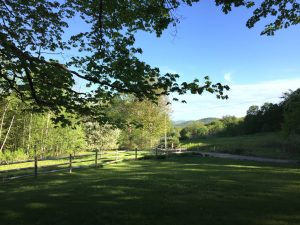

“Do not doubt but believe”: The promise of eco-resurrection
I am speaking to you from western Massachusetts. It is good to be with you. I hope that wherever you are sheltering in place in this difficult time, you have access to a corner of God’s Creation, whether it be a garden or a stretch of woods, a tree on a city sidewalk or a patch of blue sky outside your window. In times of anxiety and stress, many of us instinctively want to head outside to make contact with the natural world, for it is here that God so often brings us comfort and solace, here where we renew our relationship with the web of life that God entrusted to our care.
Our Easter readings, prayers, and hymns suggest that Christ’s death and resurrection are good news not only for human beings but also for the whole Creation – for river and mountain, whale and sparrow, forest and field. At the Great Vigil of Easter, when we mark Jesus’ passing from death to life, one of the first things we do is listen to an ancient chant: Rejoice and sing now, all the round earth, bright with a glorious splendor, for darkness has been vanquished by our eternal King.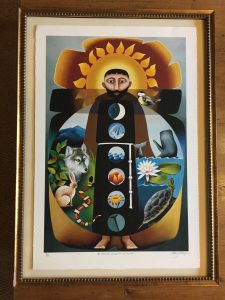
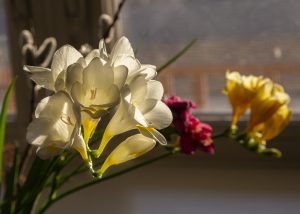
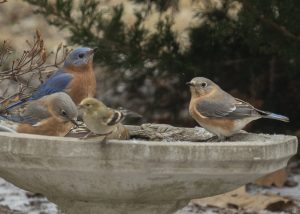
With Leah Schade, Margaret co-wrote an article, “Earth Day turns 50: ‘The Earth is where all of us are sheltering in place,‘” published by Daily Hampshire Gazette (Northampton, MA), April 20, 2020.
At the request of Chautauqua Institution, I wrote a devotional prayer for a time of pandemic:
Jesus, you are my friend and Savior. You know me through and through, and you are with me in every part of my life: in my sadness, anger, and fear, and in my gratefulness and joy.
Gracious Jesus, on the day of your resurrection you came to your frightened disciples and breathed the Holy Spirit into them. Breathe into me, as you breathed into them, the same creative wind and energy that moved across the face of the deep at the very beginning of creation.
As I breathe in, I breathe in your courage and strength. As I breathe out, I breathe out your loving-kindness and compassion.
Help me to remember that you are with me always and that every day you invite me to bear witness to your healing love. Thank you for the people you have given me to love and for the tasks you have given me to do. Give me the guts, audacity and resolve to stand up in the midst of a great catastrophe and to do what is mine to do.
Speak in my heart and grant me the peace that passes understanding, so that I may know in my deepest core that whether I live or die, I am yours, and you will never leave me.
— The Rev. Dr. Margaret Bullitt-Jonas
Week One 2020 Chaplain (June 28–July 3)
Missioner for Creation Care
Episcopal Diocese of Western Massachusetts & Southern New England Conference, United Church of Christ
April 13, 2020
____________________________________________________________________________________________________
During this time of pandemic, Chautauqua Institution is sending out a weekly prayer from a range of religious traditions. Each prayer can be downloaded for personal use (to download the prayer card, click here).
Arise to new life: Easter for Earth and for all
What a blessing to be with you! I’ve been looking forward to seeing your faces and joining in worship with you on this Easter morning. I was invited to preach because I’m your conference’s Missioner for Creation Care. I know that many of you are deeply concerned about addressing climate change and protecting the web of life that God entrusted to our care. As you know, we are about to celebrate the 50th anniversary of Earth Day, and surely the pandemic we are now enduring has made it clear that we belong to one connected family on Earth. We share a single planet, drink from the same water, breathe the same air, and face the same dangers.
The coronavirus is communicating very swiftly and without words the same message that climate scientists have been trying urgently to convey for many years: science matters; how we treat the natural world affects our well-being; the sooner we mobilize for action, the less suffering will take place; and if we are sufficiently motivated, we have the capacity to make drastic changes very quickly and to suspend business as usual. That’s a good thing, because business as usual is wrecking the planet. We simply can’t keep burning fossil fuels or keep destroying biodiversity and wild habitats and expect to survive. But what I want to speak about today is our inner lives. How is it with your soul? How are you doing? These weeks have been so hard, so full of uncertainty, loss, and fear. Our lives have been turned upside down, and as individuals and a global community, we are deeply aware of our vulnerability to suffering and death.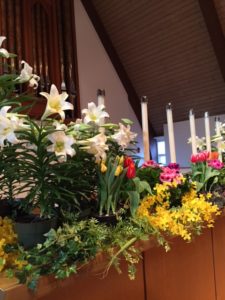 In the old days – that is, before the pandemic – we Christians could skip Holy Week and Good Friday, if we wanted to, and just show up at church on Easter morning. When we skip Holy Week and Good Friday, it’s easy to imagine that Easter is a stand-alone miracle, just a feel-good event that gives us a chance to dress up, get together with family and friends, maybe hold an Easter egg hunt and enjoy a nice meal.
Well, I confess that right now that sounds pretty good. But here’s the thing: this year, maybe more than any other, we’re being asked to experience the full meaning and power of the Easter miracle. Because this year we can’t skip Good Friday. It’s not a choice this time: we are undergoing a collective trauma and we can’t pretend, even for a day, that suffering and death aren’t real. To have any meaning – much less the power to transform lives – the miracle of Easter must speak to our actual condition.
Thanks be to God, Easter is not like the miracles we’re most familiar with, the kind that are nice and small and safe. The “miracles” that our society generally accepts are the ones that make life pleasant and don’t give anyone any trouble. We water our plants with Miracle-Gro. We mix our tuna-fish with MiracleWhip. We listen to ads that boast the latest “miracle” in computer software or laundry detergent or hair replacement. Society tells us that the only miracles that are real are the ones you buy in your local store. Miracles are trivial things, consumer items, commodities: buy one, buy several. Stock your shelves. Either miracles aren’t real, society tells us, or if they are real, they’re not very important and they don’t matter much.
But this year, unlike other years, we’ve taken a deep dive into Good Friday and we know, perhaps more acutely than ever, that the first Easter did not arrive in soft pastel tones, shrink-wrapped in plastic. Jesus truly despaired and groaned and bled on the Cross. His suffering was real; his death was real. Our faith has nothing to do with fantasy, with gazing fondly into space and ignoring the suffering or brutality of the world. No, as Christians we look squarely into suffering and death, and we glimpse the Easter miracle when we discover that even here, right here in our grief, confusion, and fear, we are met by a divine love that weeps with us and grieves with us and embraces us and empowers us, a love that will never let us go, a love that will never die.
The Gospel story of the first Easter gives us many images: a great earthquake – an angel, bright as lightning, who rolls back the stone and sits on it – an empty tomb – the discovery that Jesus is alive – and two women overcome with fear and great joy. This is not a petty miracle, a trifling little story that makes you gape or shrug and then turn away. This miracle is so potentially transformative that it scares the powers that be, and they try to deny it and suppress news of it.
After Jesus is buried, a squad of Roman soldiers, following Pilate’s orders, seals up the tomb, and stands guard before it. But human efforts to prevent the Resurrection are impossible. God’s life, God’s power burst forth. The guards, who are there to guarantee the finality of Christ’s death, become themselves, in Matthew’s ironic words, “like dead men” (Matthew 28:4), terrified of the new life bursting forth before their very eyes. The miracle has taken place. Nothing can stop it. The religious and civic authorities are shocked, and, as Matthew tells it, they rush to set up an elaborate scheme of lies to hide the news as best they can – for the Resurrection is a miracle that makes a difference.
In the old days – that is, before the pandemic – we Christians could skip Holy Week and Good Friday, if we wanted to, and just show up at church on Easter morning. When we skip Holy Week and Good Friday, it’s easy to imagine that Easter is a stand-alone miracle, just a feel-good event that gives us a chance to dress up, get together with family and friends, maybe hold an Easter egg hunt and enjoy a nice meal.
Well, I confess that right now that sounds pretty good. But here’s the thing: this year, maybe more than any other, we’re being asked to experience the full meaning and power of the Easter miracle. Because this year we can’t skip Good Friday. It’s not a choice this time: we are undergoing a collective trauma and we can’t pretend, even for a day, that suffering and death aren’t real. To have any meaning – much less the power to transform lives – the miracle of Easter must speak to our actual condition.
Thanks be to God, Easter is not like the miracles we’re most familiar with, the kind that are nice and small and safe. The “miracles” that our society generally accepts are the ones that make life pleasant and don’t give anyone any trouble. We water our plants with Miracle-Gro. We mix our tuna-fish with MiracleWhip. We listen to ads that boast the latest “miracle” in computer software or laundry detergent or hair replacement. Society tells us that the only miracles that are real are the ones you buy in your local store. Miracles are trivial things, consumer items, commodities: buy one, buy several. Stock your shelves. Either miracles aren’t real, society tells us, or if they are real, they’re not very important and they don’t matter much.
But this year, unlike other years, we’ve taken a deep dive into Good Friday and we know, perhaps more acutely than ever, that the first Easter did not arrive in soft pastel tones, shrink-wrapped in plastic. Jesus truly despaired and groaned and bled on the Cross. His suffering was real; his death was real. Our faith has nothing to do with fantasy, with gazing fondly into space and ignoring the suffering or brutality of the world. No, as Christians we look squarely into suffering and death, and we glimpse the Easter miracle when we discover that even here, right here in our grief, confusion, and fear, we are met by a divine love that weeps with us and grieves with us and embraces us and empowers us, a love that will never let us go, a love that will never die.
The Gospel story of the first Easter gives us many images: a great earthquake – an angel, bright as lightning, who rolls back the stone and sits on it – an empty tomb – the discovery that Jesus is alive – and two women overcome with fear and great joy. This is not a petty miracle, a trifling little story that makes you gape or shrug and then turn away. This miracle is so potentially transformative that it scares the powers that be, and they try to deny it and suppress news of it.
After Jesus is buried, a squad of Roman soldiers, following Pilate’s orders, seals up the tomb, and stands guard before it. But human efforts to prevent the Resurrection are impossible. God’s life, God’s power burst forth. The guards, who are there to guarantee the finality of Christ’s death, become themselves, in Matthew’s ironic words, “like dead men” (Matthew 28:4), terrified of the new life bursting forth before their very eyes. The miracle has taken place. Nothing can stop it. The religious and civic authorities are shocked, and, as Matthew tells it, they rush to set up an elaborate scheme of lies to hide the news as best they can – for the Resurrection is a miracle that makes a difference.
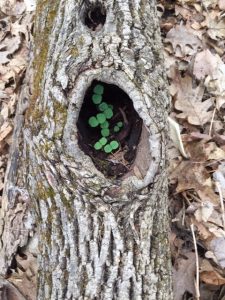
What are the connections between the novel coronavirus and the climate crisis? Margaret is the first speaker on a panel sponsored by UCC Council for Climate Justice, convened on April 1, 2020, by the Rev. Brooks Berndt, PhD (Minister for Environmental Justice, UCC). Other panelists include the Rev. Dr. Leah Schade (Assistant Professor of Preaching and Worship, Lexington Theological Seminary), the Rev. Dr. Jim Antal (Special Advisor on Climate Justice to UCC General Minister and President), and Penny Hooper (Leadership Council Chair, North Carolina Interfaith Power & Light)
Earth Day 2020 comes at a tumultuous time. COVID-19 has upended our lives. The number of infections keeps soaring world-wide and entire countries are sheltering in place.
Out of caution, many are keeping physical distance from each other. But out of compassion, many are helping any way they can — staying connected by phone or internet with those who are lonely; sewing masks for desperate health care workers; making donations to groups that help migrants and the homeless; pushing for policies that protect the lowest-earning members of society.
If there was ever a time in which humanity should finally recognize that we belong to one connected family on Earth, this should be it. We share a single planet, drink from the same water and breathe the same air.

So, whether hunkered down at home or hospital, or working on the front lines, we are all doing our part to face a common enemy together. When COVID-19 is finally behind us, instead of returning to normal life, we must hold on to these lessons in the fight against climate change.
Below are 6 lessons the coronavirus pandemic can teach us about our response to climate change.
- Science matters
We can save lives by funding, accessing and understanding the best science available. The science on climate change has been clear for decades, but we’ve failed in communicating the danger to the public, leading to slow action and widespread denial of the facts.
- How we treat the natural world affects our well-being.
The loss of habitat and biodiversity creates conditions for lethal new viruses and diseases like COVID-19 to spill into human communities. And if we continue to destroy our lands, we also deplete our resources and damage our agricultural systems.
- The sooner we mobilize for action, the less suffering will take place.
Quick and drastic action can flatten the curve for coronavirus and free up healthcare resources, lowering death rates. Similarly, drastic action on climate change could reduce food and water shortages, natural disasters and sea level rise, protecting countless individuals and communities.
- We have the ability to make drastic changes very quickly.
When sufficiently motivated, we can suspend business as usual to help each other. All over the world, healthy people are changing their lifestyles to protect the more vulnerable people in their communities. Similar dedication for climate change could transform our energy consumption immediately. All of us can make a difference and play an important role in the solution.
- All of us are vulnerable to crisis, though unequally.
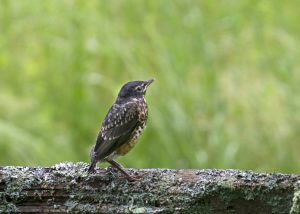
Those with underlying social, economic or physical vulnerabilities will suffer most. A society burdened with social and economic inequality is more likely to fall apart in a crisis. We must also recognize that industries and people who profit from an unjust status quo will try to interrupt the social transformation that a crisis requires.
- Holding on to a vision of a just, peaceful and sustainable Earth will give us strength for the future.
Earth Day 2020 will be remembered as a time when humanity was reeling from a pandemic. But we pray that this year will also be remembered as a time when we all were suddenly forced to stop what we were doing, pay attention to one another and take action.
Business as usual — digging up fossil fuels, cutting down forests and sacrificing the planet’s health for profit, convenience and consumption — is driving catastrophic climate change. It’s time to abandon this destructive system and find sustainable ways to inhabit our planet.
What would it look like if we emerged from this pandemic with a fierce new commitment to take care of each other? What would it look like to absorb the lessons of pandemic and to fight for a world in which everyone can thrive?
On this 50th anniversary of Earth Day, as fear and illness sweep the globe, we listen for voices that speak of wisdom, generosity, courage and hope. And as always, we find solace in the natural world. In the suddenly quiet streets and skies, we can hear birds sing.
——————————————————————————————————————————————
This essay was co-written by Margaret Bullitt-Jonas and Leah D. Schade, co-editors of the book Rooted and Rising: Voices of Courage in a Time of Climate Crisis (Rowman & Littlefield, 2019), an anthology of essays from religious environmental activists on finding the spiritual wisdom for facing the difficult days ahead. This essay was published by Earth Day Network on March 25, 2020.
